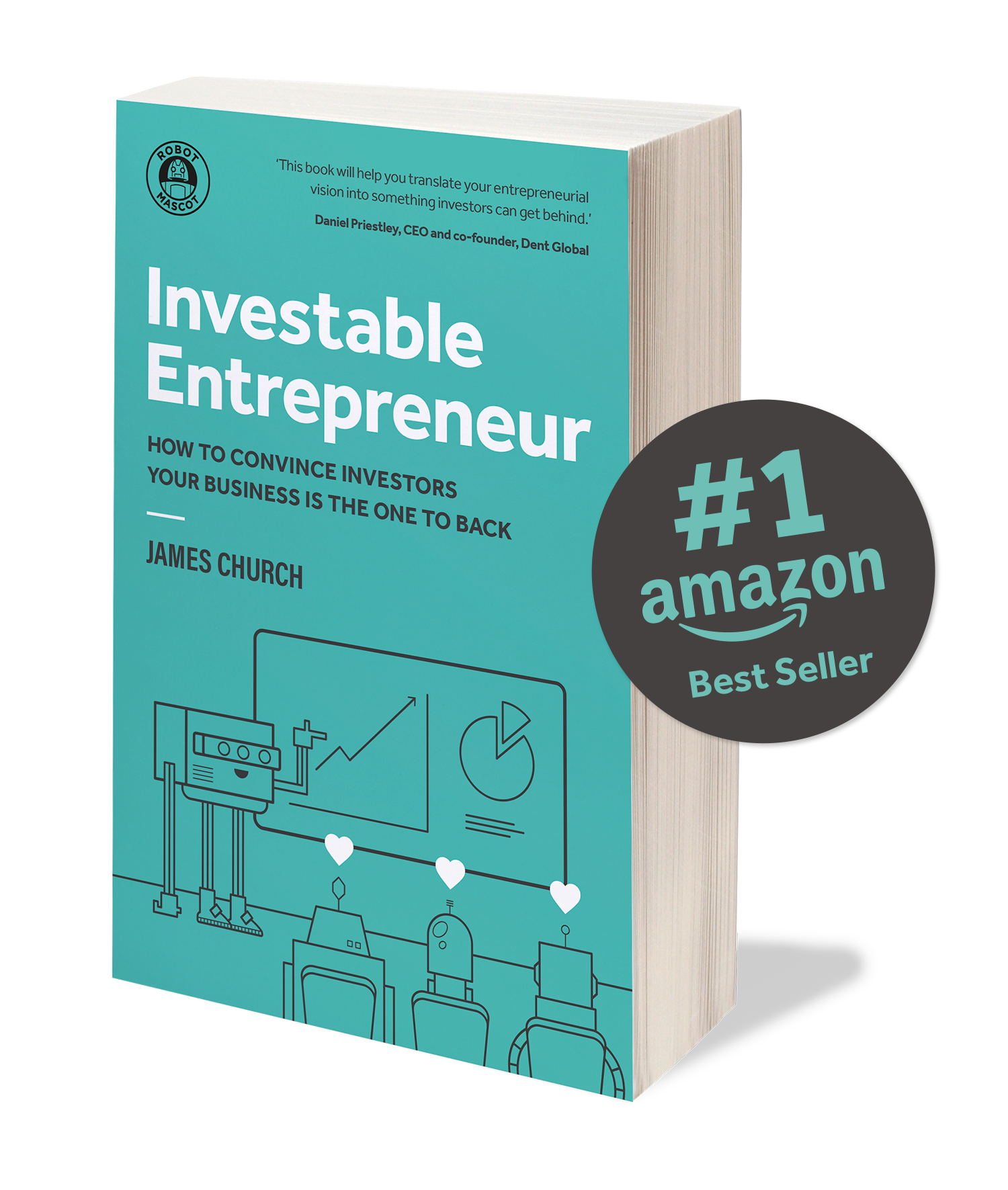

How to Value a Business
18th June 2023
What’s my company valuation
Valuing a business is a complex process that requires a lot of research, analysis, and understanding of the market. As an entrepreneur, you may want to sell your business, acquire a new one, or determine its worth. Whatever the reason, it is essential to value a business accurately to make informed decisions.
Here at Robot Mascot, we’re experts in creating investment materials, including independent valuation reports that utilise sophisticated software, big data and five different valuation methods. We also provide lots of free resources to founders seeking investment, for example, our Business Valuation Calculator – a template you can download and use. You can download and use this template to help you value your business using the VC method, but don’t forget that we can help you with many more aspects of seeking investment – especially helping you develop your pitch.
Below is a step-by-step guide on the various aspects of business valuation.
Jump to the following sections:
- What is a business valuation?
- Why work out the value of your business?
- What affects the value of a business?
- How do you value a business?
- What is the easiest way to value a business?
- Example of asset valuation
- Example of times revenue valuation
- Example of price-to-earnings valuation
- How to secure a good business valuation.
What is a business valuation?

Business valuation is a necessary process that helps determine the economic value of a business. A professional valuer often performs this valuation, analysing the business’s financial performance, assets, liabilities and market demand. Valuation will result in an estimated price at which the company could be sold.
Valuations are done for various reasons, such as when a business owner is looking to sell their business, when a company is merging with another, or when a business seeks to raise funds from investors or lenders.
By understanding the value of their business, entrepreneurs can make informed decisions about the future of their business and make strategic decisions about growth and expansion.
Why work out the value of your business?
- Knowing the value of your business can help you determine how much equity to give away when seeking funding from investors or venture capitalists. This information can be used to negotiate better terms and ensure you are giving away only a little of your business.
- Understanding the value of your business can help you make strategic decisions about growth and expansion. If the value of your business is lower than expected, you can reassess your strategy and make changes to improve the business’s value. On the other hand, if the value is higher than expected, you might use the information to make decisions about selling the company or bringing on additional investors.
- If you are considering selling your business, you must know the company’s value to ensure you get a fair price.
What affects the value of a business?
What affects the value of a business?

The value of a business is influenced by various internal and external factors. These factors can be broadly categorised into tangible assets, intangible assets, financial records, sectors and people.
Tangible assets
These are physical assets that a business owns, such as buildings, land, equipment, inventory and vehicles and can play a significant role in determining the value of a company, as they can be sold or used to generate income. A business with a high value of tangible assets is often seen as a more secure investment and may be more attractive to potential buyers.
Intangible assets
On the other hand, intangible assets are non-physical assets such as patents, trademarks, copyrights and goodwill (the value of its brand, customer base and reputation associated with its intellectual property). These assets are not easily quantifiable but can be significant in determining the overall value of a business.
Financial records
Financial records are another vital factor that affects the value of a business. A company’s financial records provide insight into its profitability, liquidity and financial health. Businesses with vital financial records, such as consistent revenue growth, low debt-to-equity ratios and healthy profit margins, are often valued higher than businesses with poor financial records.
Sector
The sector in which a business operates also plays a significant role in determining its value. For example, companies in high-growth sectors, such as technology, healthcare or renewable energy, are often valued higher due to the potential for future growth and profitability.
People
Finally, the people within a business, such as the leadership team and employees, can significantly impact its value. Companies with strong leadership and a talented workforce are often seen as more valuable and better positioned for future success.
How do you value a business?

Below is a list of the most frequently used methods for calculating the value of a company:
Discounted Cash Flow (DCF) Analysis
This is a widely accepted method for valuing a business and involves estimating the future cash flows of a company and discounting them back to their present value. It considers the time value of money and the risk associated with future cash flows.
Comparable Analysis
The comparable analysis method is another commonly used method for valuing a business and involves comparing the company to similar ones in the same industry that have been sold recently. The analysis uses financial metrics such as revenue, earnings and multiples to arrive at an estimated value.
Precedent Transaction Method
Similar to the comparative analysis method, but this approach doesn’t look at similar businesses sold recently. Instead, it looks at similar companies involved in a merger and considers the premium paid for the purchase, using it to arrive at an estimated value for the business.
Industry Best Practice
Industry best practices are used to determine the value of a business in a specific industry and can include key performance indicators, benchmarking, and other metrics. This is often used for companies with complex operations, such as manufacturing or technology.
Entry Valuation
This method determines the value of a business that is just starting or has yet to generate any revenue. It looks at the potential for growth, market size and other factors to estimate the value of the business.
Asset Valuation
The asset valuation method involves adding up the value of all the assets the business owns, including tangible and intangible assets. It is often used for companies with significant assets, such as real estate or intellectual property.
Times Revenue Method
The times revenue method is a quick and easy way to value a business – see our example below. The process involves multiplying the business’ revenue by a multiple, determined by the industry and the business size – often used for small companies with predictable revenue streams.
Price/Earnings Ratio and Other Ratios
The price/earnings ratio is another commonly used method for valuing a business – see our example below. This ratio compares the price of the business to its earnings per share. Other ratios, such as the price-to-sales and the price-to-book ratios, can also be used to value a company.
The VC Method
Used by venture capital firms to determine the value of an early-stage company, this approach involves calculating the expected future exit valuation in 5-10 years. The projected EBITDA in the anticipated exit year (taken from the startups forecasts) is multiplied by an industry benchmark EBITDA multiple to give the projected exit valuation. This value is then discounted by the level of return the investors wish to achieve from the investment to calculate the value they would need to invest at today to achieve the returns they require in the future.
READ: 5 ways to value your startup for investors
READ: Top 5 financial projection and valuation tools
What is the easiest way to value a business?

For small businesses, the easiest and quickest way to determine their value is to use the times revenue method. This involves multiplying the business’s revenue by a multiple, which is determined by the industry and the size of the business. Read our example below.
Another easy method for valuing a business is to use the price-to-earnings ratio (P/E ratio). The P/E ratio compares the price of the business to its earnings per share. This method is often used for publicly-traded companies, and the ratio can be easily obtained from financial websites. Read our example below.
However, it’s important to note that these methods only provide a rough estimate of a business’s value and should not be relied upon exclusively. The times revenue method and P/E ratio do not take into account many important factors that can influence a business’s value, such as assets, liabilities, growth potential, and competition.
Example of asset valuation
For example, suppose you are valuing a manufacturing company that produces furniture. To use the asset valuation method, you would start by estimating the current market value of the company’s assets, including its factory, equipment, and inventory. Then, you would subtract the company’s liabilities, such as outstanding debts and taxes, to arrive at the net asset value.
Suppose the market value of the company’s assets is estimated to be £1 million, and the company has liabilities of £200,000. In that case, the company’s net asset value is £800,000.
Example of times revenue valuation
For example, let’s say you’re interested in valuing a digital marketing agency. The company’s revenue for the last year was £500,000, and you’re looking to use the times revenue method to determine its value. Typically, the multiples for service-based businesses range from 1.5 to 3 times annual revenue.
If you use a multiple of 2 times annual revenue, the valuation of the digital marketing agency would be £1 million (£500,000 x 2). However, if you use a higher multiple of 3 times annual revenue, the valuation would be £1.5 million (£500,000 x 3).
It’s important to note that the multiples used in the times revenue method can vary depending on several factors, including the size of the business, industry, and market conditions. Therefore, it’s important to consider the specifics of the valued company and use a multiple appropriate for the industry and market conditions.
The times revenue method is a relatively simple way to value a business, but it does have limitations. It does not take into account a range of factors, including the business’s assets, liabilities, growth potential, competition, and market conditions, which can all affect the value of a business. As with the asset valuation method, it is important to use it in conjunction with other valuation methods, such as discounted cash flow analysis, comparable analysis, or asset valuation, to arrive at a more comprehensive valuation.
Example of price-to-earnings valuation
Let’s take the example of a UK-based company we’ve just made up: Asimov Ltd, a software development company.
Asimov Ltd has reported an earning per share (EPS) of £2.50 per share for the most recent fiscal year. The company’s stock is currently trading at £25 per share.
To calculate the P/E ratio for Asimov Ltd, we divide the stock price (£25) by the EPS (£2.50), which gives us a P/E ratio of 10. This means that investors are willing to pay 10 times the company’s earnings per share for a share of Asimov Ltd’s stock.
Let’s assume that we want to determine the value of Asimov Ltd based on its P/E ratio. We can use a similar formula to calculate the company’s value. First, we must estimate the company’s earnings for the next fiscal year. Let’s assume that we expect Asimov Ltd to have an EPS of £3.00 per share for the next fiscal year.
To calculate the estimated value of Asimov Ltd, we multiply the EPS estimate (£3.00) by the P/E ratio (10), which gives us a value of £30 per share. This means that, based on its P/E ratio, the estimated value of Asimov Ltd is £30 per share.
To get the total company value, we would simply multiply £30 by the total number of shares in issue (the total number of shares in issue will be derived from the companies Cap Table).
As mentioned above. P/E ratios can vary widely between industries and companies, so using this valuation method in conjunction with other ways to arrive at a fair and accurate value is essential.
How to secure a good business valuation

The valuation of your business will impact your ability to secure financing, attract investors and plan for future growth, so it’s essential to ensure you can achieve a good (but realistic) valuation. Here are some tips on how you can secure a good business valuation.
Have a Good Business Plan
A well-crafted business plan is a vital tool for entrepreneurs. It will help you to articulate your vision, objectives and strategies for your business. It should also include your financial projections, which will form the basis for your business valuation. A clear and realistic business plan can demonstrate the value of your business to potential investors, lenders or buyers.
Have Your Finances in Order
Good financial records can help you to demonstrate the profitability and sustainability of your business, which can increase your valuation, so make sure that you have accurate financial statements, including balance sheets, income statements and cash flow statements. Also, keep track of your expenses and revenues and ensure that your records are up to date. If you are a pre-revenue startup you will not be able to demonstrate many of these things – however a solid financial model will allow you to show how you plan to manage your finances, deliver sustainable profitability and mitigate financial risk.
Reduce Risk
Identify and mitigate any risks that could negatively impact the value of your business. This might include financial, legal, operational, and reputational risks. You can reduce risk by implementing good governance, having a solid risk management strategy and investing in insurance.
Don’t Overestimate Your Business’ Value
Many entrepreneurs make the mistake of overestimating the value of their business, so be realistic about your business’s value and use multiple valuation methods to arrive at a fair and accurate value. Overestimating your business’s value can make attracting investors, lenders or buyers more challenging and even harm your reputation.
Seek Professional Advice
Seeking professional advice from a business valuer, accountant, or financial advisor can help you to arrive at an accurate valuation. A professional can help you identify your business’s key value drivers, evaluate your financial statements and choose the correct valuation methods. They can also help you to identify areas of improvement that could increase the value of your business. In the meantime, why not download the Business Valuation Calculator template and let us help you value your own business?
FAQs
Q. How long does it take to value a business?
A. Valuing a business can take anywhere from a few weeks to a few months, depending on the size and complexity of the business.
Q. Can I value my own business?
A. It is possible to value your own business, but it is recommended to seek the advice of a professional valuer to ensure accuracy.
Q. Can the valuation of a business change over time?
A. Yes, the valuation of a business can change over time based on various factors, such as changes in the industry, financial performance, and market demand.
Valuing a business is a crucial step for entrepreneurs to make informed decisions. There are several methods and factors to consider when valuing a business. By valuing a business accurately, entrepreneurs can make informed decisions about their business’s future.
How To Value A Business
Investable Entrepreneur takes you through our winning methodology – the process we use to increase our client’s chances of raising investment by more than 30x.
“This book will help you translate your entrepreneurial vision into something investors can get behind.”
Daniel Priestley, CEO and founder, Dent Global and four times best-selling business author

Keep up to date with what we’re up to via email






Copyright ©Robot Mascot Ltd. All rights reserved.




